Evaluation of Biodiversity Maintenance Capacity in Forest Landscapes: A Case Study in Beijing, China
Abstract
1. Introduction
2. Materials and Methods
2.1. Study Area and Data Sources
2.2. Methods
2.2.1. Construction of Biodiversity Potentiality Evaluation Model
- (1)
- Carbon sink model
- (2)
- Habitat quality model
2.2.2. Selection and Calculation of Landscape Pattern Indices
2.2.3. Spatial Autocorrelation Analysis
2.2.4. Geographical Weighted Regression Analysis
3. Results
3.1. Land Use Structure Change
3.2. Patterns and Changes for the BMC of Forest Landscapes
3.3. Landscape Patterns Change
3.4. Spatial Autocorrelation Analysis Results of the BMC of Forest Landscapes
3.5. Effects of Landscape Patterns on the BMC of Forest Landscapes
4. Discussion
4.1. Spatial and Temporal Changes of the BMC and Landscape Patterns in Beijing
4.2. Driving Mechanism of Landscape Pattern on the BMC of Forest Landscapes
5. Conclusions
- (1)
- The overall BMC of forest landscapes in Beijing improved from 2005 to 2020, with the average value rising from 0.798 to 0.822. In the urban center and suburban regions, 36.02 km2 of forests experienced a slight decline. In the transition zone connecting suburban and mountainous regions, about 3.26% of forests experienced a significant decline. Increasing the aggregation of high-quality, healthy, and stable forests is critical to preventing landscape fragmentation and promoting material cycling and capacity flow. In the mountainous region with a low intensity of human disturbance and high elevation, about 11.83% of forests remained stable, and 60.46% and 23.68% of the forests experienced slight and significant improvement, respectively. It is necessary to strengthen the management of nature reserves, build a biodiversity conservation network, and limit the encroachment of human activities on ecologically fragile and sensitive areas.
- (2)
- The landscape pattern changed significantly from 2005 to 2020 in Beijing. As a whole, landscape intermixing and compactness decreased slightly by 11.45% and 7.82%, while landscape connectivity and diversity increased significantly by 64.28% and 55.44%, respectively. In the mountainous region, the intermixing of the landscape decreased significantly, while the diversity and connectivity increased. It shows that the overall landscape pattern of the mountainous area has improved. In future planning and development, it is necessary to continuously strengthen ecological conservation and restoration to reduce landscape diversity and confounding. At the same time, measures such as artificial afforestation, hill-closing afforestation, young growth tending, and low-quality forest transformation should be taken to ensure that the ecological function remain unchanged. In the suburban region, the landscape compactness decreased across a wide range, while the intermixing, diversity, and connectivity increased. The urban green belt dominated by forest land can actively promote the transformation of construction space to ecological space, avoid the reduction in ecological space area caused by disorderly urban expansion, and help to increase ecological connectivity and optimize the forest–grass composite structure. Although landscape diversity increased in the urban center, it always remained at a low level. Landscape intermixing, compactness, and connectivity showed a significant increase. Reducing landscape compactness and increasing landscape diversity, intermixing, and connectivity are conducive to alleviating the adverse consequences of the clustering of urbanized land on the BMC of forest landscapes. Under the guidance of urban renewal policy, we encourage expanding urban forest areas and optimizing the blue-green space structure by shifting construction space.
- (3)
- The global Moran’s I of the BMC in 2005 and 2020 was 0.711 and 0.782, respectively, showing a spatial bipolar agglomeration feature. Districts with high values were distributed in the western and northern high-altitude mountainous regions; districts with low values were located in the urban center and peri-urban suburbs with high density urbanization. The change in BMC of forest landscapes in Beijing was significantly correlated with a change in landscape pattern. Landscape compactness had the most significant effect, followed by landscape diversity, intermixing, and connectivity. The increase in compactness had a negative effect on BMC in areas with low values of BMC and a positive effect in areas with high values of BMC. An increase in landscape diversity and intermixing can alleviate the ecological pressure brought by high-density urbanization of land in the urban center and provide opportunities for embedding forest patches with high values of BMC. In addition, through the development of forest parks, pocket parks shaded streets, and other forms of green spaces to further increase and create new ecosystem services [89], the beneficial impacts of landscape connectivity may gradually increase. In contrast, for the mountainous regions with high BMC values, increasing landscape diversity and intermixing may expand the negative effects of human disturbance. Increased landscape connectivity positively affected BMC in the urban center and mountainous regions, indicating that patches with high-value BMC on low-value BMC substrates tend to be connected. It is necessary to increase the diversity and intermixing of the landscape and reduce the compactness of urbanized land by constructing near-natural forest ecosystems [66]. For peri-urban suburbs, an increase in landscape connectivity had a negative effect because urbanization promotes the connections between various fragments of previously urbanized land. It is vital to control the speed and shape of urban sprawl by establishing wedge-shaped or ring-shaped isolated forest belts.
Supplementary Materials
Author Contributions
Funding
Data Availability Statement
Acknowledgments
Conflicts of Interest
References
- Grimm, N.B.; Faeth, S.H.; Golubiewski, N.E.; Redman, C.L.; Wu, J.; Bai, X.; Briggs, J.M. Global change and the ecology of cities. Science 2008, 319, 756–760. [Google Scholar] [CrossRef] [PubMed]
- Marselle, M.R.; Lindley, S.J.; Cook, P.A.; Bonn, A. Biodiversity and health in the urban environment. Curr. Environ. Health Rep. 2021, 8, 146–156. [Google Scholar] [CrossRef] [PubMed]
- Pörtner, H.O.; Scholes, R.J.; Agard, J.; Archer, E.; Arneth, A.; Bai, X.; Barnes, D.; Burrows, M.; Chan, L.; Cheung, W.L. IPBES, IPCC Co-Sponsored Workshop Report on Biodiversity and Climate Change; Intergovernmental Science-Policy Platform on Biodiversity and Ecosystem Services (IPBES) and Intergovernmental Panel on Climate Change (IPCC): Bonn, Germany, 2021; pp. 24–32. [Google Scholar]
- McDonald, R.I.; Mansur, A.V.; Ascensão, F.; Colbert, M.; Crossman, K.; Elmqvist, T.; Gonzalez, A.; Güneralp, B.; Haase, D.; Hamann, M.; et al. Research gaps in knowledge of the impact of urban growth on Biodiversity. Nat. Sustain. 2019, 3, 16–24. [Google Scholar] [CrossRef]
- Cardinale, B.J.; Duffy, J.E.; Gonzalez, A.; Hooper, D.U.; Perrings, C.; Venail, P.; Naeem, S. Biodiversity loss and its impact on humanity. Nature 2012, 486, 59–67. [Google Scholar] [CrossRef]
- Nielsen, A.B.; Hedblom, M.; Olafsson, A.S.; Wiström, B. Spatial configurations of urban forest in different landscape and socio-political contexts: Identifying patterns for green infrastructure planning. Urban Ecosyst. 2017, 20, 379–392. [Google Scholar] [CrossRef]
- Nowak, D.J.; Hoehn, R.E.; Bodine, A.R.; Greenfield, E.J.; O’Neil-Dunne, J. Urban Forest Structure, Ecosystem Services and change in Syracuse, NY. Urban Ecosyst. 2013, 19, 1455–1477. [Google Scholar] [CrossRef]
- Kangas, J.; Ollikainen, M. A PES scheme promoting forest biodiversity and carbon sequestration. For. Policy Econ. 2022, 136, 102692. [Google Scholar] [CrossRef]
- Xiao, P.; Zhou, Y.; Li, M.; Xu, J. Spatiotemporal patterns of habitat quality and its topographic gradient effects of Hubei province based on the invest model. Environ. Dev. Sustain. 2022, 25, 6419–6448. [Google Scholar] [CrossRef]
- Alaniz, A.J.; Carvajal, M.A.; Fierro, A.; Vergara-Rodríguez, V.; Toledo, G.; Ansaldo, D.; Moreira-Arce, D.; Rojas-Osorio, A.; Vergara, P.M. Remote-sensing estimates of forest structure and dynamics as indicators of habitat quality for Magellanic woodpeckers. Ecol. Indic. 2021, 126, 107634. [Google Scholar] [CrossRef]
- Lee, D.; Jeon, S.W. Estimating changes in habitat quality through land-use predictions: Case study of roe deer (Capreolus Pygargus tianschanicus) in Jeju Island. Sustainability 2020, 12, 10123. [Google Scholar] [CrossRef]
- Regolin, A.L.; Oliveira-Santos, L.G.; Ribeiro, M.C.; Bailey, L.L. Habitat quality, not habitat amount, drives mammalian habitat use in the Brazilian Pantanal. Landsc. Ecol. 2021, 36, 2519–2533. [Google Scholar] [CrossRef]
- Song, S.; Liu, Z.; He, C.; Lu, W. Evaluating the effects of urban expansion on natural habitat quality by coupling localized shared socioeconomic pathways and the land use scenario dynamics-urban model. Ecol. Indic. 2020, 112, 106071. [Google Scholar] [CrossRef]
- Zhu, C.; Zhang, X.; Zhou, M.; He, S.; Gan, M.; Yang, L.; Wang, K. Impacts of urbanization and landscape pattern on habitat quality using OLS and GWR models in Hangzhou, China. Ecol. Indic. 2020, 117, 106654. [Google Scholar] [CrossRef]
- He, J.; Huang, J.; Li, C. The evaluation for the impact of land use change on habitat quality: A joint contribution of cellular automata scenario simulation and habitat quality assessment model. Ecol. Model. 2017, 366, 58–67. [Google Scholar] [CrossRef]
- Venter, O.; Koh, L.P. Reducing emissions from deforestation and forest degradation (REDD+): Game changer or just another quick fix? Ann. N. Y. Acad. Sci. 2012, 1249, 137–150. [Google Scholar] [CrossRef]
- Buotte, P.C.; Law, B.E.; Ripple, W.J.; Berner, L.T. Carbon sequestration and biodiversity co-benefits of preserving forests in the western united states. Ecol. Appl. 2019, 30, 2039. [Google Scholar] [CrossRef] [PubMed]
- Rahman, M.A.; Moser, A.; Gold, A.; Rötzer, T.; Pauleit, S. Vertical air temperature gradients under the shade of two contrasting urban tree species during different types of summer days. Sci. Total Environ. 2018, 633, 100–111. [Google Scholar] [CrossRef]
- Nero, B.F.; Callo-Concha, D.; Denich, M. Structure, diversity, and carbon stocks of the tree community of Kumasi, Ghana. Forests 2018, 9, 519. [Google Scholar] [CrossRef]
- Ferreira, J.; Lennox, G.D.; Gardner, T.A.; Thomson, J.R.; Berenguer, E.; Lees, A.C.; Barlow, J. Carbon-focused conservation may fail to protect the most biodiverse tropical forests. Nat. Clim. Chang. 2018, 8, 744–749. [Google Scholar] [CrossRef]
- Leveau, L.M. Primary productivity and habitat diversity predict bird species richness and composition along urban-rural gradients of Central Argentina. Urban For. Urban Green. 2019, 43, 126349. [Google Scholar] [CrossRef]
- Paul, K.I.; Roxburgh, S.H. Predicting carbon sequestration of woody biomass following land restoration. For. Ecol. Manag. 2020, 460, 117838. [Google Scholar] [CrossRef]
- Chu, X.; Zhan, J.; Li, Z.; Zhang, F.; Qi, W. Assessment on forest carbon sequestration in the three-north shelterbelt program region, China. J. Clean. Prod. 2019, 215, 382–389. [Google Scholar] [CrossRef]
- Zhao, J.; Xie, H.; Ma, J.; Wang, K. Integrated Remote Sensing and model approach for impact assessment of future climate change on the carbon budget of Global Forest Ecosystems. Global Planet. Chang. 2021, 203, 103542. [Google Scholar] [CrossRef]
- Ye, X.; Chuai, X. Carbon Sinks/sources’ spatiotemporal evolution in China and its response to built-up land expansion. J. Environ. Manag. 2022, 321, 115863. [Google Scholar] [CrossRef] [PubMed]
- Zhao, S.M.; Ma, Y.F.; Wang, J.L.; You, X.Y. Landscape Pattern Analysis and ecological network planning of Tianjin City. Urban For. Urban Green. 2019, 46, 126479. [Google Scholar] [CrossRef]
- Ahmadi Mirghaed, F.; Souri, B. Relationships between habitat quality and ecological properties across Ziarat Basin in Northern Iran. Environ. Dev. Sustain. 2021, 23, 16192–16207. [Google Scholar] [CrossRef]
- Chen, W.Y.; Li, X. Urban forests’ recreation and habitat potentials in China: A nationwide synthesis. Urban For. Urban Green. 2021, 66, 127376. [Google Scholar] [CrossRef]
- Zhou, Z.X.; Li, J. The correlation analysis on the landscape pattern index and hydrological processes in the Yanhe watershed, China. J. Hydrol. 2015, 524, 417–426. [Google Scholar] [CrossRef]
- Mitchell, M.G.; Wu, D.; Johansen, K.; Maron, M.; McAlpine, C.; Rhodes, J.R. Landscape structure influences urban vegetation vertical structure. J. Appl. Ecol. 2016, 53, 1477–1488. [Google Scholar] [CrossRef]
- Ren, Y.; Wei, X.; Wang, D.; Luo, Y.; Song, X.; Wang, Y.; Yang, Y.; Hua, L. Linking landscape patterns with ecological functions: A case study examining the interaction between landscape heterogeneity and carbon stock of urban forests in Xiamen, China. For. Ecol. Manag. 2013, 293, 122–131. [Google Scholar] [CrossRef]
- Han, Y.; Kang, W.; Thorne, J.; Song, Y. Modeling the effects of landscape patterns of current forests on the habitat quality of historical remnants in a highly urbanized area. Urban For. Urban Green. 2019, 41, 354–363. [Google Scholar] [CrossRef]
- Sonti, N.F.; Riemann, R.; Mockrin, M.H.; Domke, G.M. Expanding wildland-urban interface alters forest structure and landscape context in the Northern United States. Environ. Res. Lett. 2022, 18, 014010. [Google Scholar] [CrossRef]
- Mitchell, M.G.E.; Devisscher, T. Strong relationships between urbanization, landscape structure, and ecosystem service multifunctionality in urban forest fragments. Landsc. Urban Plan. 2022, 228, 104548. [Google Scholar] [CrossRef]
- Pickard, B.R.; Van Berkel, D.; Petrasova, A.; Meentemeyer, R.K. Forecasts of urbanization scenarios reveal trade-offs between landscape change and Ecosystem Services. Landsc. Ecol. 2016, 32, 617–634. [Google Scholar] [CrossRef]
- Lv, H.; Yang, Y.; Zhang, D.; Du, H.; Zhang, J.; Wang, W.; He, X. Perimeter-area ratio effects of urbanization intensity on forest characteristics, landscape patterns and their associations in Harbin city, Northeast China. Urban Ecosyst. 2019, 22, 631–642. [Google Scholar] [CrossRef]
- Li, Q.; Jin, T.; Peng, Q.; Lin, J.; Zhang, D.; Huang, J.; Liu, B. Identifying the extent of the spatial expression of landscape fragmentation based on scale effect analysis in Southwest China. Ecol. Indic. 2022, 141, 109120. [Google Scholar] [CrossRef]
- Maseko, M.S.; Zungu, M.M.; Ehlers Smith, D.A.; Ehlers Smith, Y.C.; Downs, C.T. Effects of habitat-patch size and patch isolation on the diversity of forest birds in the urban-forest mosaic of durban, South Africa. Urban Ecosyst. 2020, 23, 533–542. [Google Scholar] [CrossRef]
- Wang, J.; Zhou, W.; Pickett, S.T.A.; Yu, W.; Li, W. A multiscale analysis of urbanization effects on Ecosystem Services Supply in an urban megaregion. Sci. Total Environ. 2019, 662, 824–833. [Google Scholar] [CrossRef]
- Li, H.; Peng, J.; Yanxu, L.; Yi’na, H. Urbanization impact on landscape patterns in Beijing City, China: A spatial heterogeneity perspective. Ecol. Indic. 2017, 82, 50–60. [Google Scholar] [CrossRef]
- Marín, A.I.; Abdul Malak, D.; Bastrup-Birk, A.; Chirici, G.; Barbati, A.; Kleeschulte, S. Mapping forest condition in Europe: Methodological developments in support to Forest Biodiversity assessments. Ecol. Indic. 2021, 128, 107839. [Google Scholar] [CrossRef]
- Gao, J.; Tang, X.; Lin, S.; Bian, H. The influence of land use change on key ecosystem services and their relationships in a mountain region from past to future (1995–2050). Forests 2021, 12, 616. [Google Scholar] [CrossRef]
- Xu, X.; Yang, G.; Tan, Y.; Tang, X.; Jiang, H.; Sun, X.; Zhuang, Q.; Li, H. Impacts of land use changes on net ecosystem production in the Taihu Lake Basin of China from 1985 to 2010. J. Geophys. Res. Biogeosci. 2017, 122, 690–707. [Google Scholar] [CrossRef]
- Ersoy Mirici, M.; Satir, O.; Berberoglu, S. Monitoring the Mediterranean type forests and land-use/cover changes using appropriate landscape metrics and hybrid classification approach in eastern Mediterranean of Turkey. Environ. Earth Sci. 2020, 79, 492. [Google Scholar] [CrossRef]
- Devi, A.R.; Shimrah, T. Assessment of Land Use and land cover and forest fragmentation in traditional landscape in Manipur, Northeast India. Int. J. Environ. Sci. Technol. 2021, 19, 10291–10306. [Google Scholar] [CrossRef]
- Zhang, D.; Wang, W.; Zheng, H.; Ren, Z.; Zhai, C.; Tang, Z.; Shen, G.; He, X. Effects of urbanization intensity on forest structural-taxonomic attributes, landscape patterns and their associations in Changchun, Northeast China: Implications for urban green infrastructure planning. Ecol. Indic. 2017, 80, 286–296. [Google Scholar] [CrossRef]
- Mandal, M.; Chattarjee, N.D. Geo-statistical analysis to understand nature of forest patch shape complexity in panchet forest division under Bankura district, West Bengal. Indian J. Ecol. 2020, 47, 96–101. [Google Scholar]
- Mengist, W.; Soromessa, T.; Feyisa, G.L. Landscape change effects on habitat quality in a Forest Biosphere Reserve: Implications for the conservation of native habitats. J. Clean. Prod. 2021, 329, 129778. [Google Scholar] [CrossRef]
- Qiu, C.L.; Wang, C.X.; Zhang, R. Characteristics of ecological space carbon sequestration service function and its relationship with landscape pattern in Beijing-Tianjing-Hebei urban agglomeration. Acta Ecol. Sin. 2022, 42, 9590–9603. [Google Scholar]
- Camba Sans, G.H.; Verón, S.R.; Paruelo, J.M. Forest strips increase connectivity and modify forests’ functioning in a deforestation hotspot. J. Environ. Manag. 2021, 290, 112606. [Google Scholar] [CrossRef]
- Palmero-Iniesta, M.; Espelta, J.M.; Gordillo, J.; Pino, J. Changes in forest landscape patterns resulting from recent afforestation in Europe (1990–2012): Defragmentation of pre-existing forest versus New Patch proliferation. Ann. For. Sci. 2020, 77, 43. [Google Scholar] [CrossRef]
- Zhang, S.; Liu, J.; Song, C.; Chan, C.S.; Pei, T.; Wenting, Y.; Xin, Z. Spatial-temporal distribution characteristics and evolution mechanism of urban parks in Beijing, China. Urban For. Urban Green. 2021, 64, 127265. [Google Scholar] [CrossRef]
- Mao, F.; Du, H.; Zhou, G.; Zheng, J.; Li, X.; Xu, Y.; Huang, Z.; Yin, S. Simulated net ecosystem productivity of subtropical forests and its response to climate change in Zhejiang Province, China. Sci. Total. Environ. 2022, 838, 155993. [Google Scholar] [CrossRef]
- Wang, C.; Zhao, W.; Zhang, Y. The change in net ecosystem productivity and its driving mechanism in a mountain ecosystem of arid regions, Northwest China. Remote Sens. 2022, 14, 4046. [Google Scholar] [CrossRef]
- Zhou, X.F.; Yu, F.; Cao, G.Z.; Yang, W.S.; Zhou, Y. Spatiotemporal features of carbon source-sink and its relationship with climate factors in Qinghai-Tibet Plateau grassland ecosystem during 2001–2015. Res. Soil Water Conserv. 2019, 26, 76–81. [Google Scholar]
- Liu, Y.; Xia, C.; Ou, X.; Lv, Y.; Ai, X.; Pan, R.; Zhang, Y.; Shi, M.; Zheng, X. Quantitative structure and spatial pattern optimization of urban green space from the perspective of carbon balance: A case study in Beijing, China. Ecol. Indic. 2023, 148, 110034. [Google Scholar] [CrossRef]
- Xu, L.; Yu, G.R.; He, N.P. Increased soil organic carbon storage in Chinese terrestrial ecosystems from the 1980s to the 2010s. J. Geogr. Sci. 2019, 29, 49–66. [Google Scholar] [CrossRef]
- Gao, J.; Bian, H. The impact of the Plains afforestation program and alternative land use scenarios on ecosystem services in an urbanizing watershed. Urban For. Urban Green. 2019, 43, 126373. [Google Scholar] [CrossRef]
- Wu, J.; Delang, C.O.; Li, Y.; Ye, Q.; Zhou, J.; Liu, H.; He, H.; He, W. Application of a combined model simulation to determine ecological corridors for western black-crested gibbons in the Hengduan Mountains, China. Ecol. Indic. 2021, 128, 107826. [Google Scholar] [CrossRef]
- Wu, L.; Sun, C.; Fan, F. Estimating the characteristic spatiotemporal variation in habitat quality using the invest model—A case study from Guangdong–Hong Kong–macao greater bay area. Remote Sens. 2021, 13, 1008. [Google Scholar] [CrossRef]
- Sallustio, L.; De Toni, A.; Strollo, A.; Di Febbraro, M.; Gissi, E.; Casella, L.; Marchetti, M. Assessing habitat quality in relation to the spatial distribution of protected areas in Italy. J. Environ. Manag. 2017, 201, 129–137. [Google Scholar] [CrossRef]
- Gong, J.; Xie, Y.; Cao, E.; Huang, Q.; Li, H. Integration of InVEST-habitat quality model with landscape pattern indexes to assess mountain plant biodiversity change: A case study of Bailongjiang watershed in Gansu Province. J. Geogr. Sci. 2019, 29, 1193–1210. [Google Scholar] [CrossRef]
- Song, Y.; Wang, M.; Sun, X.; Fan, Z. Quantitative assessment of the habitat quality dynamics in Yellow River Basin, China. Environ. Monit. Assess. 2021, 193, 614. [Google Scholar] [CrossRef] [PubMed]
- Hu, J.; Zhang, J.; Li, Y. Exploring the spatial and temporal driving mechanisms of landscape patterns on habitat quality in a city undergoing rapid urbanization based on GTWR and MGWR: The case of Nanjing, China. Ecol. Indic. 2022, 143, 109333. [Google Scholar] [CrossRef]
- Basile, M.; Storch, I.; Mikusiński, G. Abundance, species richness and diversity of forest bird assemblages—The relative importance of habitat structures and landscape context. Ecol. Indic. 2021, 133, 108402. [Google Scholar] [CrossRef]
- Su, S.; Wang, Y.; Luo, F.; Mai, G.; Pu, J. Peri-urban vegetated landscape pattern changes in relation to socioeconomic development. Ecol. Indic. 2014, 46, 477–486. [Google Scholar] [CrossRef]
- Liu, C.; Zhang, F.; Carl Johnson, V.; Duan, P.; Kung, H. Spatio-temporal variation of oasis landscape pattern in arid area: Human or natural driving? Ecol. Indic. 2021, 125, 107495. [Google Scholar] [CrossRef]
- Moran, P.A. The interpretation of Statistical Maps. J. R. Stat. Soc. B 1948, 10, 243–251. [Google Scholar] [CrossRef]
- Yanna, Z.; Gang, H.; Guisheng, Z.; Keyu, B.; Chaoyu, Y.; Xiangqian, W. Research on coupling coordination and spatial differentiation of new-type urbanization and ecological environment in Wanjiang Demonstration Area. GeoJournal 2020, 87, 1511–1523. [Google Scholar] [CrossRef]
- Peng, J.; Liu, Y.; Shen, H.; Xie, P.; Hu, X.; Wang, Y. Using impervious surfaces to detect urban expansion in Beijing of China in 2000. Chin. Geogr. Sci. 2016, 26, 229–243. [Google Scholar]
- Yang, Z.; Dong, J.; Liu, J.; Zhai, J.; Kuang, W.; Zhao, G.; Shen, W.; Zhou, Y.; Qin, Y.; Xiao, X. Accuracy assessment and inter-comparison of eight medium resolution forest products on the Loess Plateau, China. ISPRS Int. J. Geo-Inf. 2017, 6, 152. [Google Scholar] [CrossRef]
- Zhang, Y.; Zhang, T.; Zeng, Y.; Yu, C.; Zheng, S. The rising and heterogeneous demand for urban green space by Chinese urban residents: Evidence from Beijing. J. Clean. Prod. 2021, 313, 127781. [Google Scholar] [CrossRef]
- da Silva, A.L.; de Nunes, A.J.N.; Marques, M.L.; Ribeiro, A.Í.; Longo, R.M. Assessing the fragility of forest remnants by using landscape metrics. Comparison between river basins in Brazil and Portugal. Environ. Monit. Assess. 2021, 193, 172. [Google Scholar] [CrossRef] [PubMed]
- Vanderley-Silva, I.; Valente, R.A. Functional connectivity supported by forest conservation in urban sprawl landscape in São Paulo, Brazil. GeoJournal 2022, 88, 3011–3028. [Google Scholar] [CrossRef]
- Du, C. Dynamic Evaluation of Sustainable Water Resource Systems in metropolitan areas: A case study of the Beijing megacity. Water 2020, 12, 2629. [Google Scholar] [CrossRef]
- Du, Z.; Ge, L.; Ng, A.H.-M.; Lian, X.; Zhu, Q.; Horgan, F.G.; Zhang, Q. Analysis of the impact of the south-to-north water diversion project on water balance and land subsidence in Beijing, China between 2007 and 2020. J. Hydrol. 2021, 603, 126990. [Google Scholar] [CrossRef]
- Liu, W.; Chen, W.; Feng, Q.; Deo, R.C. Situations, challenges and strategies of urban water management in Beijing under rapid urbanization effect. Water Supply 2018, 19, 115–127. [Google Scholar] [CrossRef]
- Zhang, J.Z.; Li, L.W.; Zhang, Y.N.; Liu, Y.F.; Ma, W.L.; Zhang, Z.M. Using a fuzzy approach to assess adaptive capacity for urban water resources. Int. J. Environ. Sci. Technol. 2018, 16, 1571–1580. [Google Scholar] [CrossRef]
- Mu, X.; Wang, H.; Zhao, Y.; Liu, H.; He, G.; Li, J. Streamflow into Beijing and its response to climate change and human activities over the period 1956–2016. Water 2020, 12, 622. [Google Scholar] [CrossRef]
- Fan, J.; Liu, Q.; Ren, Z.; Chen, Z.; Li, W.; Yu, Y.; Zhou, Y. Nighttime luminosity transitions are tightly spatiotemporally correlated with land use changes: A pixelwise case study in Beijing, China. Ecol. Indic. 2022, 145, 109649. [Google Scholar] [CrossRef]
- Lawrence, A.; O’Connor, K.; Haroutounian, V.; Swei, A. Patterns of diversity along a habitat size gradient in a biodiversity hotspot. Ecosphere 2018, 9, e02183. [Google Scholar] [CrossRef]
- Lv, H.; Wang, W.; He, X.; Xiao, L.; Zhou, W.; Zhang, B. Quantifying Tree and soil carbon stocks in a temperate urban forest in Northeast China. Forests 2016, 7, 200. [Google Scholar] [CrossRef]
- Moro, R.S.; Milan, E. Natural forest fragmentation evaluation in the Campos Gerais region, southern Brazil. Environ. Ecol. Res. 2016, 4, 74–78. [Google Scholar] [CrossRef]
- Blumenfeld, E.C.; Dos Santos, R.F.; Thomaziello, S.A.; Ragazzi, S. Relações Entre Tipo de Vizinhança e Efeitos de Borda em Fragmento Florestal. Ciênc. Florest. 2016, 26, 1301–1316. [Google Scholar] [CrossRef]
- Longo, R.M.; Da Silva, A.L.; Bettine, S.D.C.; Demanboro, A.C.; Bressane, A.; Fengler, F.H.; Riberio, A.I. Environmental quality in urban forests in Campinas–São Paulo State/Brazil. Int. J. Environ. Impacts 2019, 2, 117–130. [Google Scholar] [CrossRef]
- Coudrain, V.; Schüepp, C.; Herzog, F.; Albrecht, M.; Entling, M.H. Habitat amount modulates the effect of patch isolation on host-parasitoid interactions. Front. Environ. Sci. 2014, 2, 27. [Google Scholar] [CrossRef]
- Strohbach, M.W.; Lerman, S.B.; Warren, P.S. Are small greening areas enhancing bird diversity? insights from community-driven greening projects in Boston. Landsc. Urban Plan. 2013, 114, 69–79. [Google Scholar] [CrossRef]
- Yang, Z.; Dong, J.; Qin, Y.; Ni, W.; Zhao, G.; Chen, W.; Chen, B.; Kou, W.; Wang, J.; Xiao, X. Integrated analyses of palsar and landsat imagery reveal more agroforests in a typical agricultural production region, North China Plain. Remote Sens. 2018, 10, 1323. [Google Scholar] [CrossRef]
- Li, F.; Zheng, W.; Wang, Y.; Liang, J.; Xie, S.; Guo, S.; Li, X.; Yu, C. Urban green space fragmentation and urbanization: A spatiotemporal perspective. Forests 2019, 10, 333. [Google Scholar] [CrossRef]
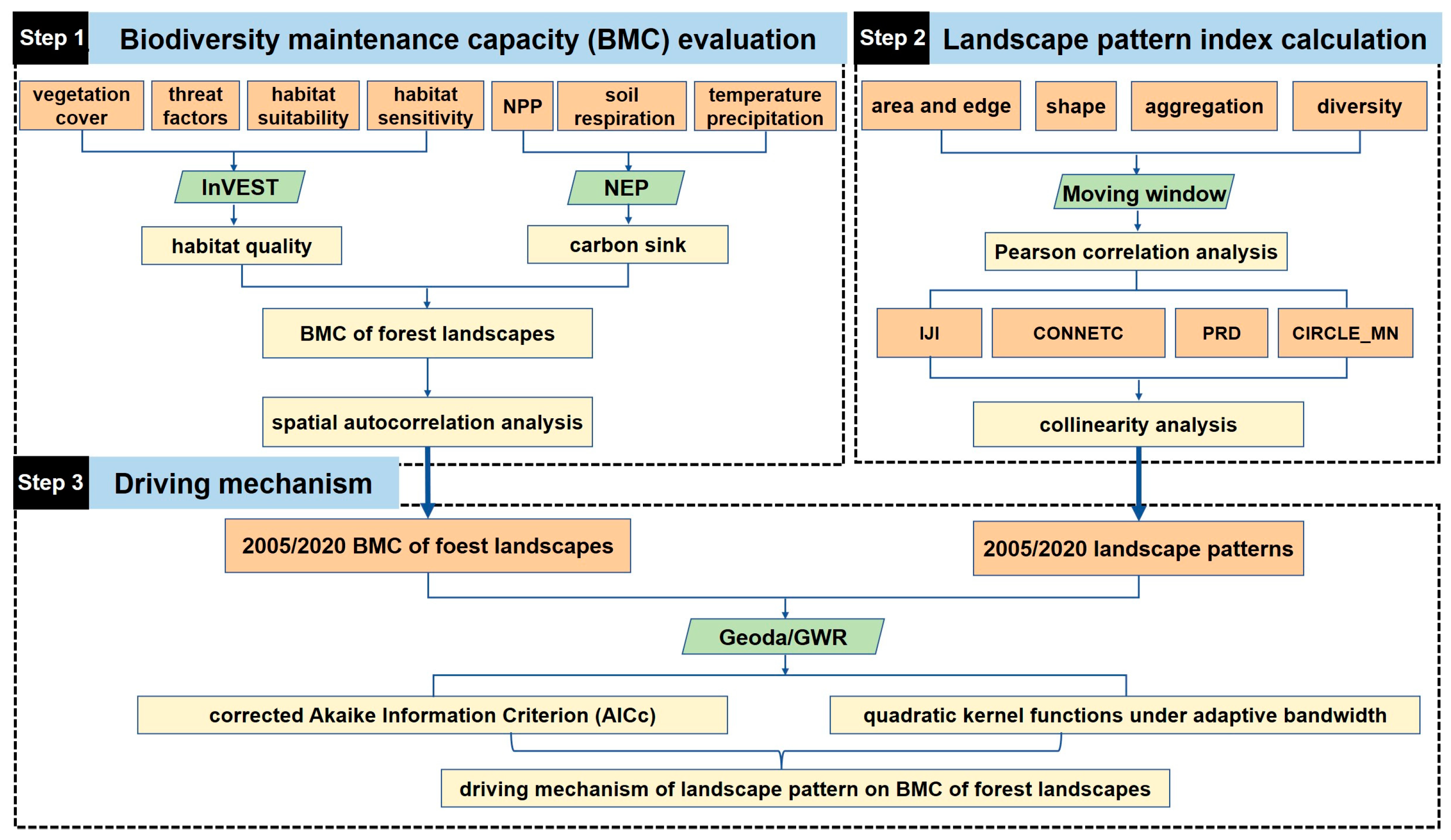
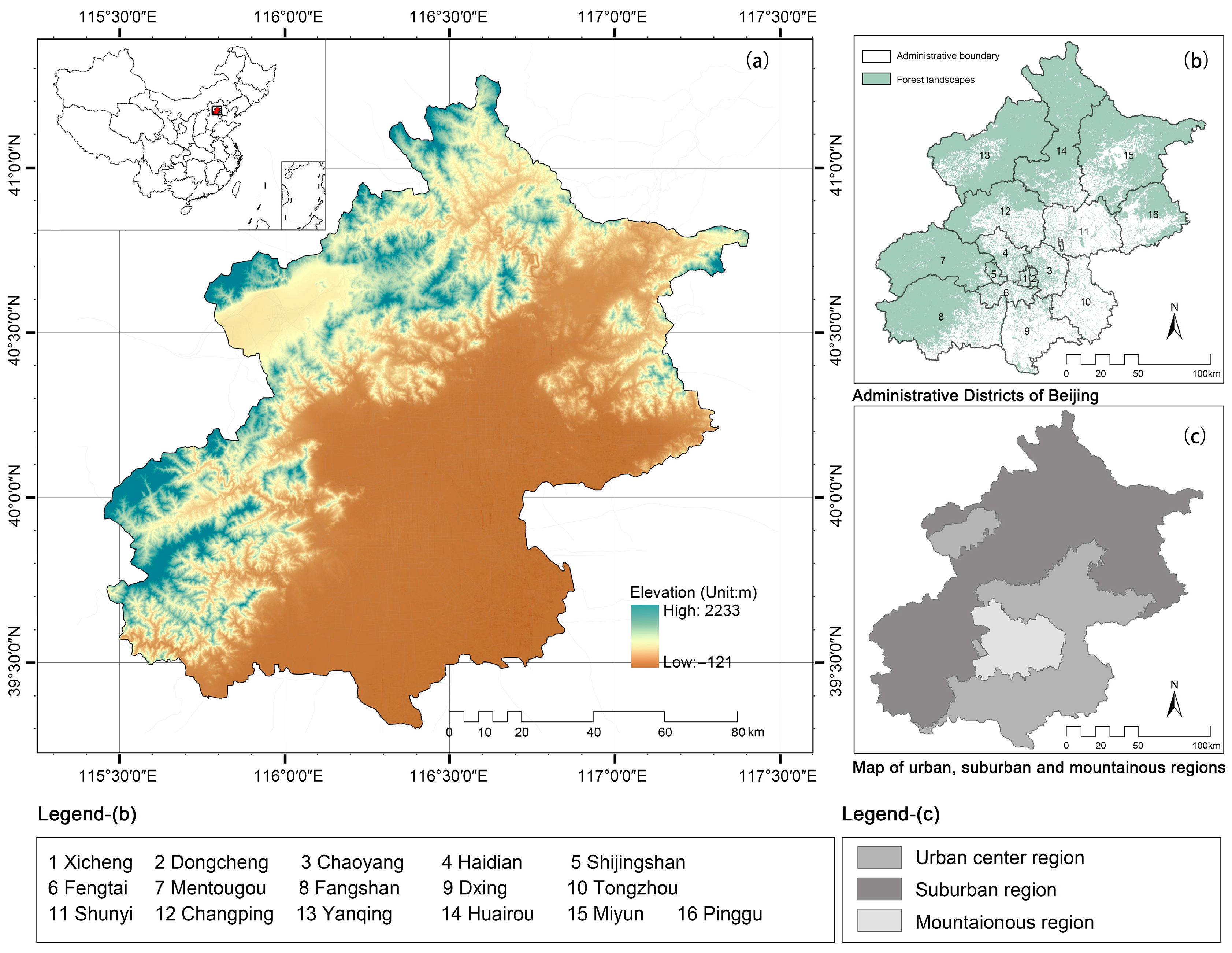
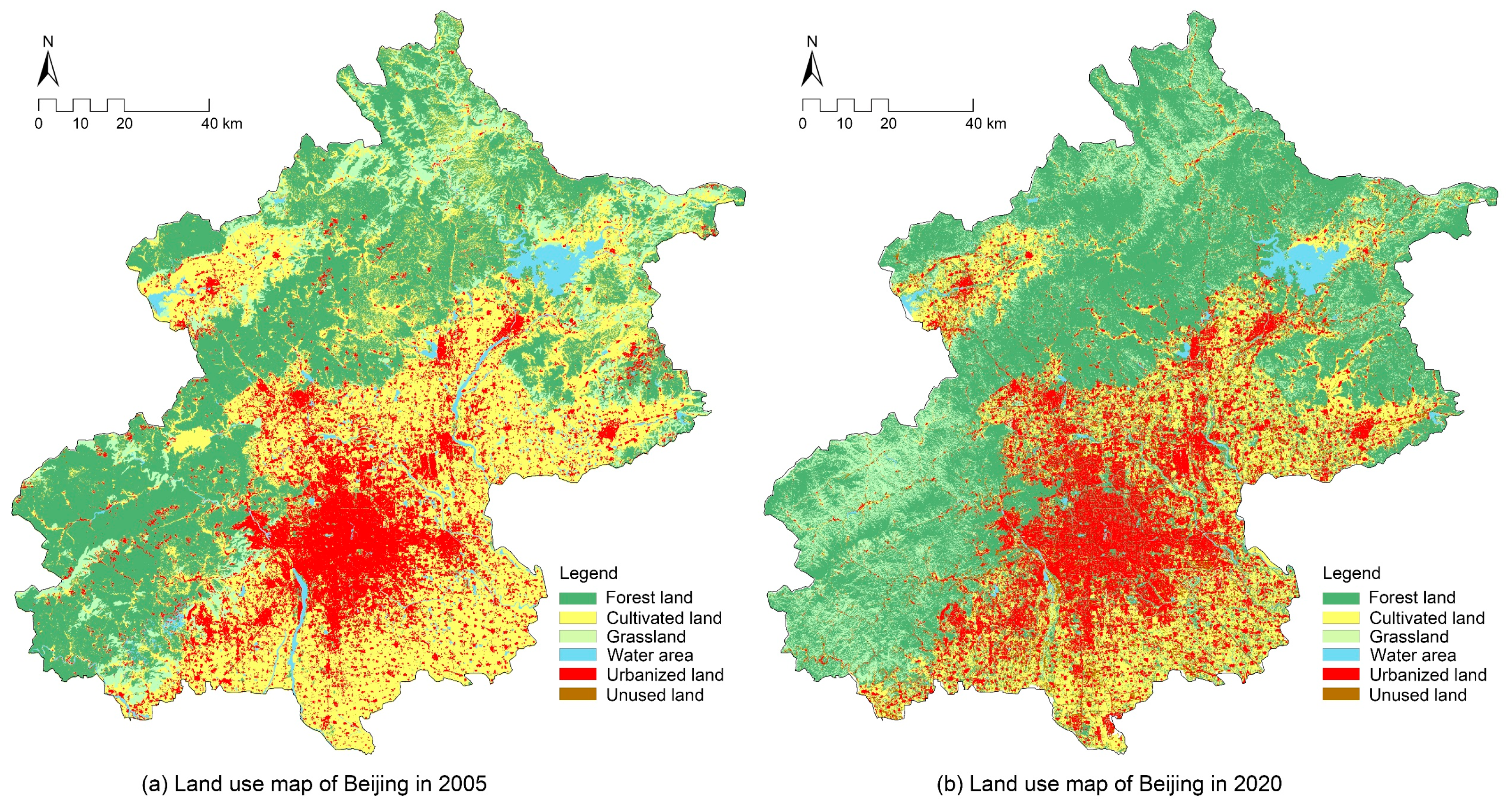
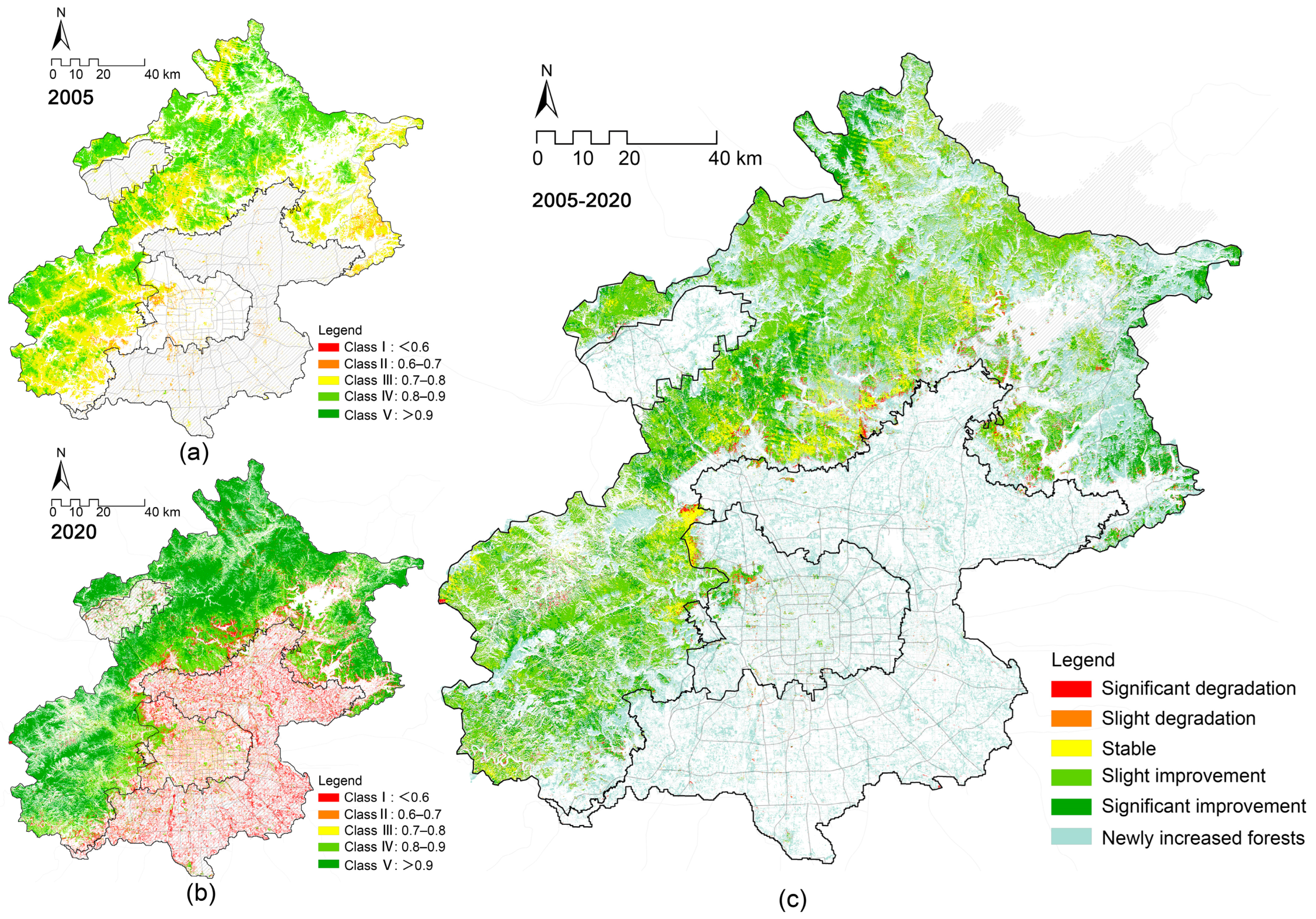

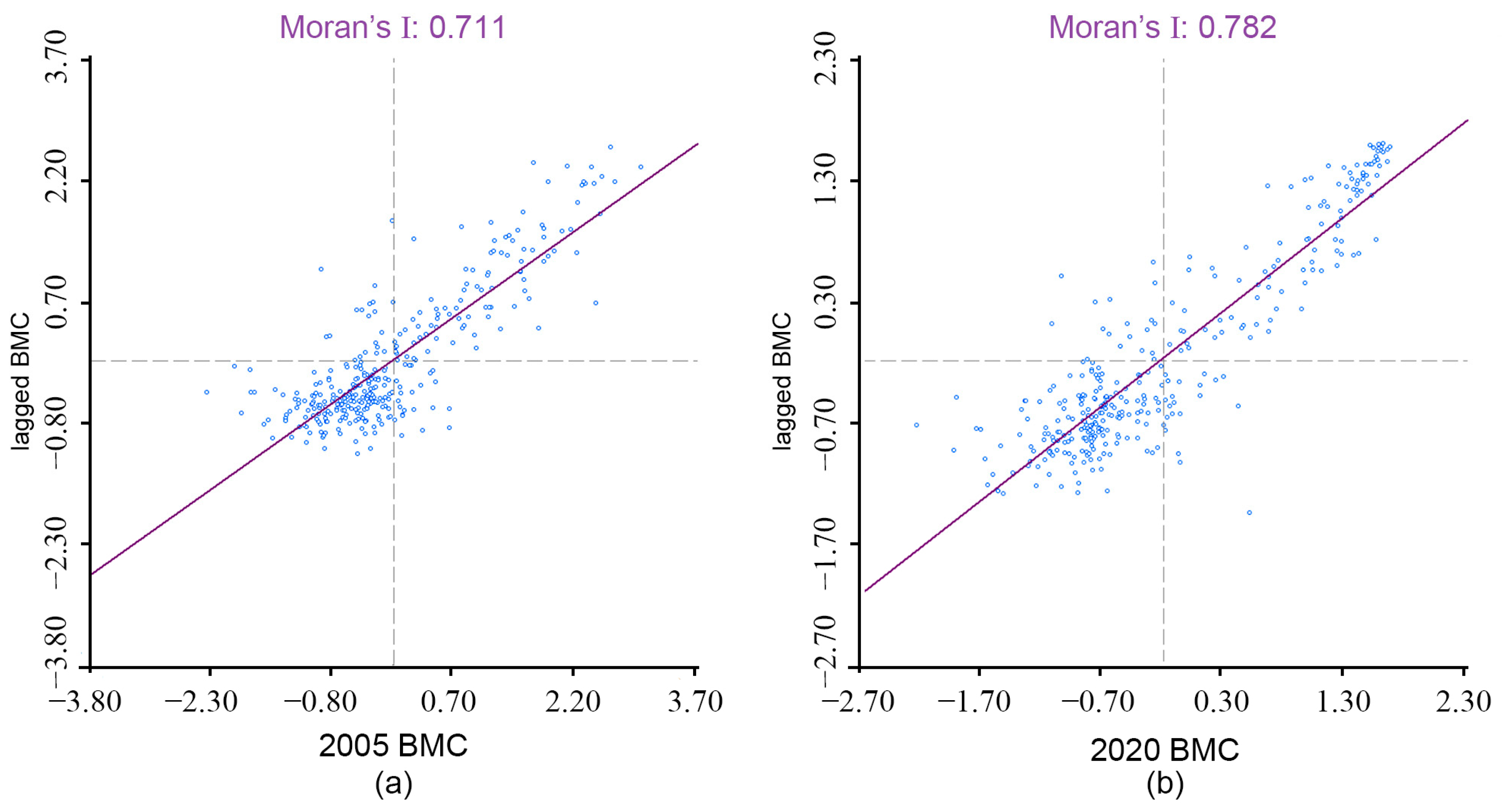
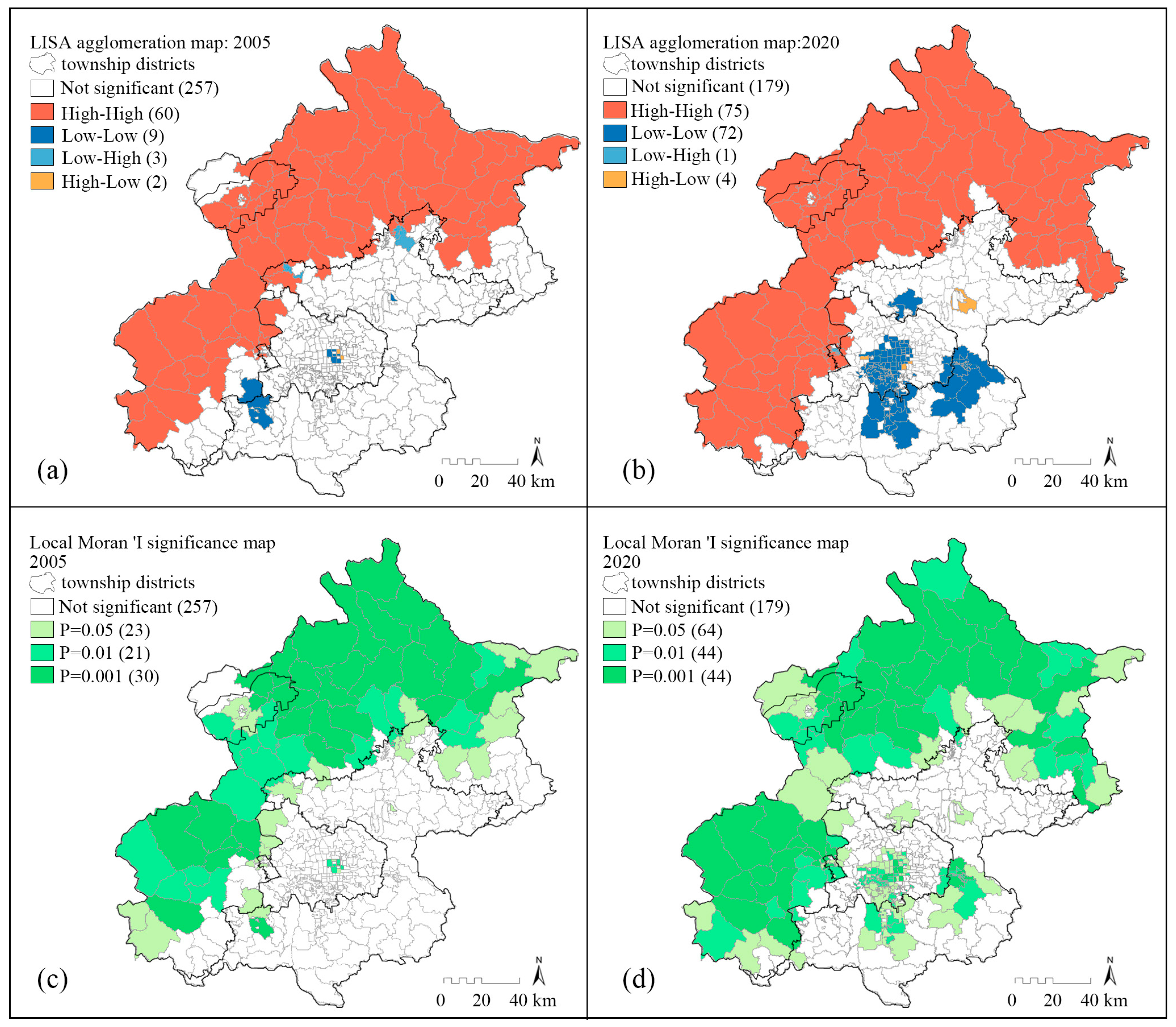
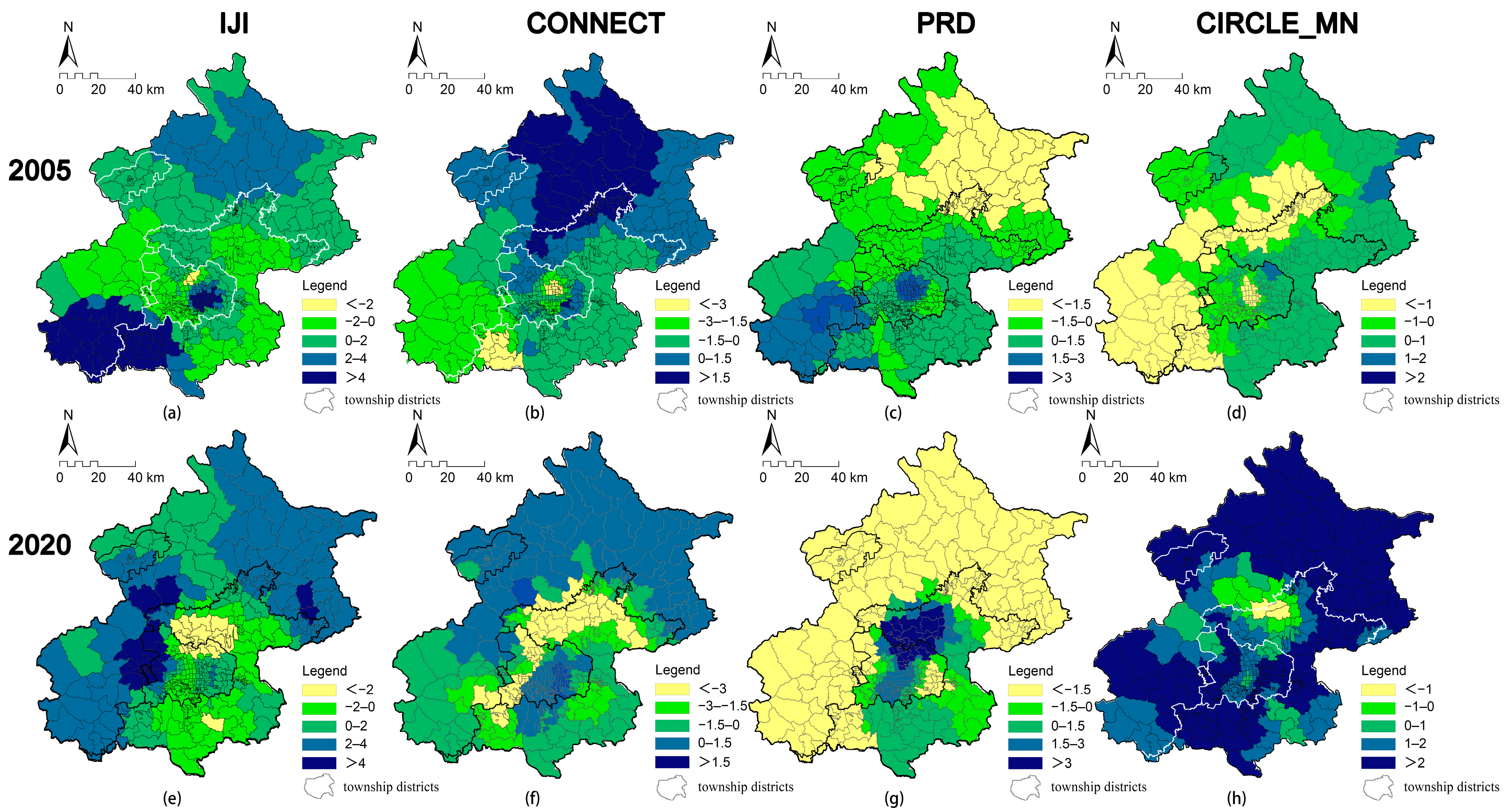
| Threat Factor | drmax | wr | Distance–Decay Function | Sensitivity |
|---|---|---|---|---|
| Cultivated land | 8 | 0.68 | Linear | 0.7 |
| Urbanized land | 10 | 1 | Exponential | 0.8 |
| Railway | 9 | 0.9 | Exponential | 0.55 |
| Primary road | 8 | 1 | Linear | 0.85 |
| Secondary road | 5 | 0.75 | Linear | 0.77 |
| Parameter | 2005 | 2020 | ||
|---|---|---|---|---|
| OLS | GWR | OLS | GWR | |
| Adjusted R2 | 0.54 | 0.68 | 0.83 | 0.86 |
| AICc | −865.64 | −817.07 | −915.12 | −884.12 |
| 2020 | Grassland | Cultivated Land | Urbanized Land | Forest Land | Water Area | Unused Land | Total | |
|---|---|---|---|---|---|---|---|---|
| 2005 | ||||||||
| Grassland | - | 66.87 | 29.33 | 712.32 | 8.12 | 36.55 | 853.18 | |
| Cultivated land | 432.94 | - | 819.83 | 1956.16 | 21.16 | 333.76 | 3563.85 | |
| Urbanized land | 56.81 | 252.51 | - | 343.77 | 15.80 | 99.66 | 768.55 | |
| Forest land | 1108.45 | 58.39 | 43.61 | - | 5.97 | 39.48 | 1255.90 | |
| Water area | 30.24 | 104.85 | 37.59 | 93.77 | - | 46.25 | 312.68 | |
| Unused land | 0.33 | 0.10 | 0.10 | 0.26 | 0.16 | - | 0.95 | |
| Total | 1628.77 | 482.71 | 930.46 | 3106.27 | 51.21 | 555.69 | 6755.11 | |
| BMC Class | 2005 | 2020 | ||
|---|---|---|---|---|
| Area | Ratio | Area | Ratio | |
| I | 0.21 | 0.01% | 1324.03 | 16.86% |
| II | 210.71 | 3.54% | 118.44 | 1.51% |
| III | 2796.15 | 46.95% | 97.03 | 1.24% |
| IV | 2834.27 | 47.59% | 2217.03 | 28.23% |
| V | 113.80 | 1.90% | 4097.64 | 52.17% |
| 2020 | I | II | III | IV | V | Total | |
|---|---|---|---|---|---|---|---|
| 2005 | |||||||
| I | 0.02 | 0.00 | 0.01 | 0.01 | 0.00 | 0.04 | |
| II | 14.85 | 1.72 | 2.48 | 67.23 | 44.13 | 130.40 | |
| III | 104.99 | 15.01 | 11.60 | 865.99 | 989.58 | 1987.17 | |
| IV | 34.54 | 10.62 | 5.18 | 426.69 | 1943.42 | 2420.45 | |
| V | 1.23 | 0.03 | 0.04 | 0.99 | 110.22 | 112.51 | |
| Total | 155.63 | 27.38 | 19.30 | 1360.90 | 3087.36 | 4650.57 | |
| Landscape Index | Average Value | Minimum Value | Median | Maximum Value | ||||
|---|---|---|---|---|---|---|---|---|
| 2005 | 2020 | 2005 | 2020 | 2005 | 2020 | 2005 | 2020 | |
| IJI | 0.002 | 0.003 | −0.007 | −0.011 | 0.002 | 0.001 | 0.017 | 0.017 |
| CONNECT | −0.001 | −0.003 | −0.011 | −0.024 | 0.000 | 0.000 | 0.015 | 0.014 |
| CIRCLE_MN | −0.321 | 1.130 | −3.042 | −1.287 | −0.069 | 1.151 | 3.802 | 2.806 |
| PRD | 0.007 | −0.009 | −0.040 | −0.060 | 0.005 | −0.003 | 0.157 | 0.038 |
Disclaimer/Publisher’s Note: The statements, opinions and data contained in all publications are solely those of the individual author(s) and contributor(s) and not of MDPI and/or the editor(s). MDPI and/or the editor(s) disclaim responsibility for any injury to people or property resulting from any ideas, methods, instructions or products referred to in the content. |
© 2023 by the authors. Licensee MDPI, Basel, Switzerland. This article is an open access article distributed under the terms and conditions of the Creative Commons Attribution (CC BY) license (https://creativecommons.org/licenses/by/4.0/).
Share and Cite
Liu, Y.; Zhao, J.; Zheng, X.; Ou, X.; Zhang, Y.; Li, J. Evaluation of Biodiversity Maintenance Capacity in Forest Landscapes: A Case Study in Beijing, China. Land 2023, 12, 1293. https://doi.org/10.3390/land12071293
Liu Y, Zhao J, Zheng X, Ou X, Zhang Y, Li J. Evaluation of Biodiversity Maintenance Capacity in Forest Landscapes: A Case Study in Beijing, China. Land. 2023; 12(7):1293. https://doi.org/10.3390/land12071293
Chicago/Turabian StyleLiu, Yang, Jing Zhao, Xi Zheng, Xiaoyang Ou, Yaru Zhang, and Jiaying Li. 2023. "Evaluation of Biodiversity Maintenance Capacity in Forest Landscapes: A Case Study in Beijing, China" Land 12, no. 7: 1293. https://doi.org/10.3390/land12071293
APA StyleLiu, Y., Zhao, J., Zheng, X., Ou, X., Zhang, Y., & Li, J. (2023). Evaluation of Biodiversity Maintenance Capacity in Forest Landscapes: A Case Study in Beijing, China. Land, 12(7), 1293. https://doi.org/10.3390/land12071293





